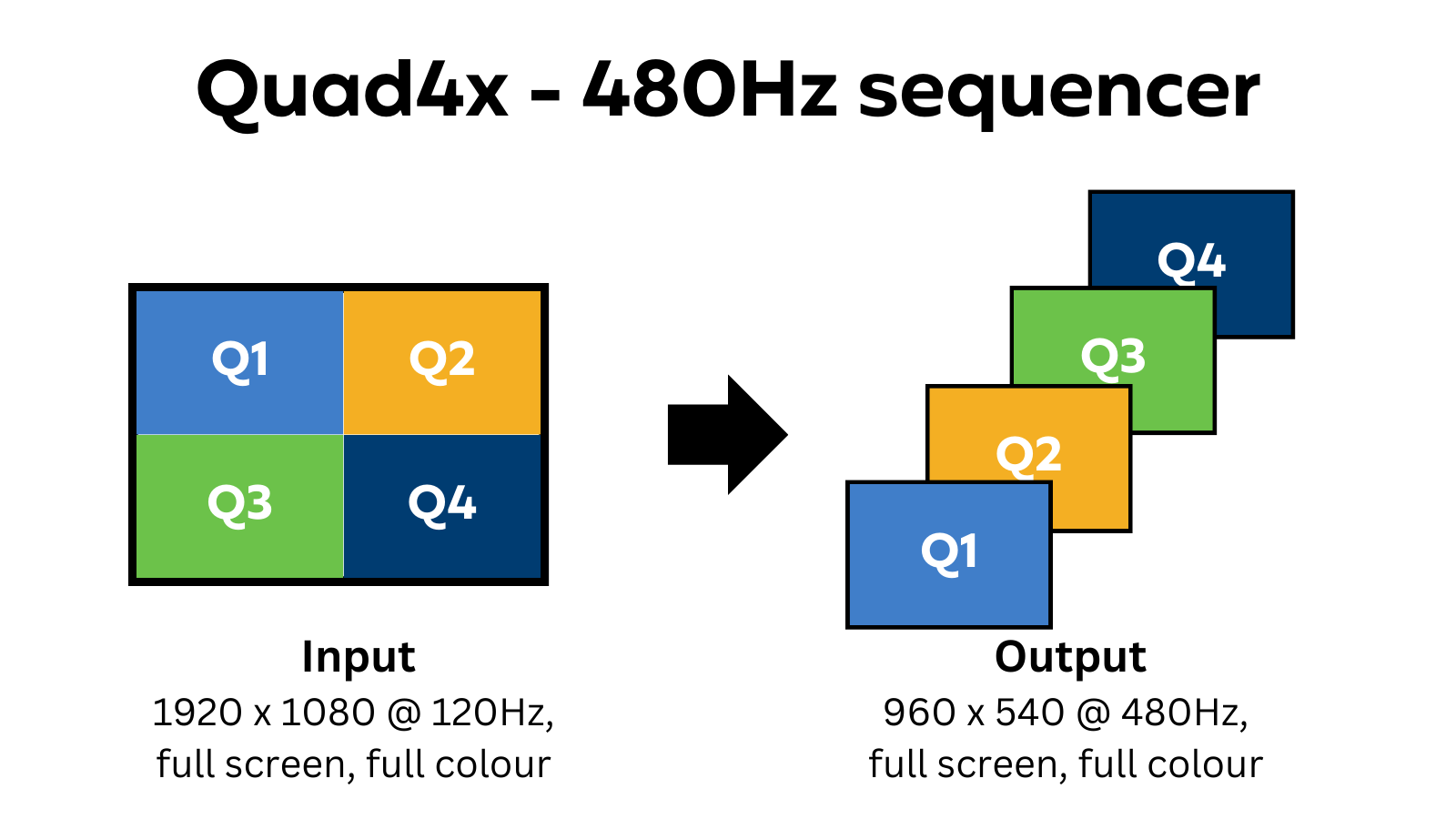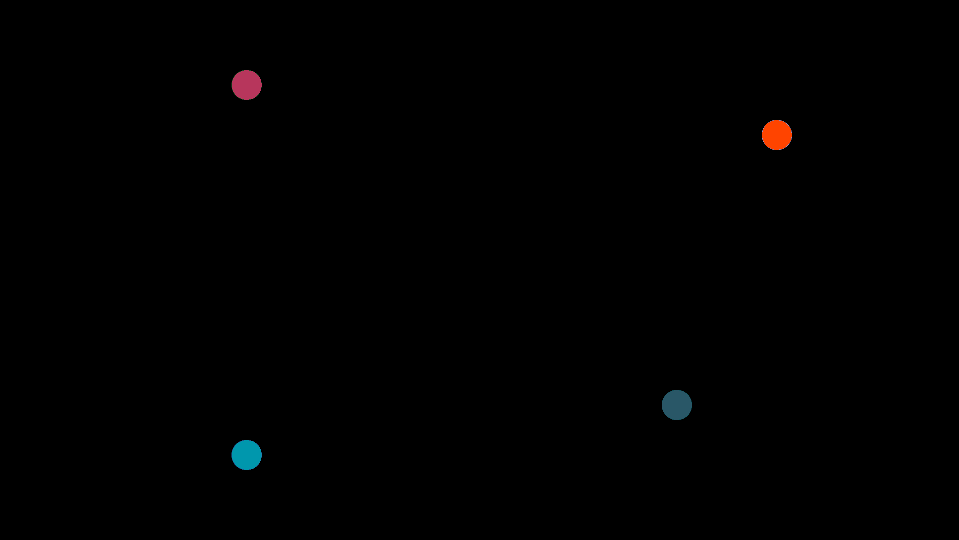This demo is a simple demonstration of the PROPixx’s 480 Hz sequencer. We show four random-color dots around the center of the screen, cycling at a rate of 480 Hz. The demo ends when a key is pressed.
Currently, there is no graphics card capable of drawing individual frames at 480 Hz. In order to achieve this refresh rate, the PROPixx uses a built-in “sequencer” that takes a 1920 x 1080, 120 Hz video signal and breaks it into multiple frames which are then displayed in sequence. In 480 Hz mode, we divide the 1920 x 1080 image into four full color 960 x 540 images, or “quadrants” and show these in a sequence starting with the top left quadrant. All quadrants are displayed full-screen.

To create our stimuli, we draw our targets as if they were full resolution, full screen. The helper script convertToQuadrant reassigns and rescales the target positon to the correct quadrant. A screen running in 120 Hz mode will show the four quadrants drawn on the same frame:

A screen running in 120 Hz mode will show the four quadrants drawn on the same frame.

The PROPixx in 480 Hz mode will display the four quadrants in sequence. Note: This animation is slowed down for demonstration purposes. At true 480 Hz, the four dots will seem to be ‘simultaneously’ visible in a diamond pattern.
function PPxDraw480HzDots
%This function draws a series of dots around the center of the
%display at 480 Hz.
% First, we construct a single 1920 x 1080 RGB image, which is passed to
% the PROPixx. The sequencer breaks the image down and shows the quadrants
% as 4 individual 960 x 540 frames, one after the other.
%_______________________________
%| | |
%| Q1 | Q2 |
%| | |
%|_____________|________________|
%| | |
%| Q3 | Q4 |
%| | |
%|_____________|________________|
%Quadrants are shown FULL SCREEN, RGB in the order Q1-Q2-Q3-Q4.
% To create stimuli, we draw our targets as if they were full resolution,
% full screen. The helper script 'convertToQuadrant' reassigns and rescales
% the target positon to the correct quadrant. Remember that each quadrant
% gets blown up to full screen, so your resolution will be halved
% vertically and horizontally.
% Made and tested with:
% -- PROPixx firmware revision 43
% -- DATAPixx3 firmware revision 19
% -- MATLAB version 9.6.0.1150989 (R2019a)
% -- Psychtoolbox version 3.0.15
% -- Datapixx Toolbox version 3.7.5735
% -- Windows 10 version 1903, 64bit
% Sep 27 2019 lef written
% Mar 26 2020 lef revised
%Check connection and open Datapixx if it's not open yet
isConnected = Datapixx('isReady');
if ~isConnected
Datapixx('Open');
end
Datapixx('SetPropixxDlpSequenceProgram', 2); %Set Propixx to 480Hz refresh (also known as Quad4x)
Datapixx('RegWrRd'); %Push command to device register
%Open a display on the Propixx
AssertOpenGL;
KbName('UnifyKeyNames')
screenID = max(Screen('Screens'));
[windowPtr,rect] = PsychImaging('OpenWindow', screenID, 0);
%Set up some stimulus characteristics
dotRadius = 30;
%Create some positions based on the regular display
center = [rect(3)/2, rect(4)/2];
radius = 200;
positions=[center(1), center(2)-radius;... %top
center(1)+radius, center(2);... %right
center(1), center(2)+radius;... %bottom
center(1)-radius, center(2)]; %left
%Start displaying dots
while 1
%Above center, random colour
quadrant = 1;
position = positions(1, :);
colour = round(rand([1,3])*255);
%Convert position to the same position in the quadrant 1 and draw
[x,y] = convertToQuadrant(position, rect, quadrant);
Screen('FillOval', windowPtr, colour, [x-dotRadius, y-dotRadius, x+dotRadius, y+dotRadius]);
%Right of center, random colour
quadrant = 2;
position = positions(2, :);
colour = round(rand([1,3])*255);
%Convert position to the same position in the quadrant 2 and draw
[x,y] = convertToQuadrant(position, rect, quadrant);
Screen('FillOval', windowPtr, colour, [x-dotRadius, y-dotRadius, x+dotRadius, y+dotRadius]);
%Below center, random colour
quadrant = 3;
position = positions(3, :);
colour = round(rand([1,3])*255);
%Convert position to the same position in the quadrant 3 and draw
[x,y] = convertToQuadrant(position, rect, quadrant);
Screen('FillOval', windowPtr, colour, [x-dotRadius, y-dotRadius, x+dotRadius, y+dotRadius]);
%Left of center, random colour
quadrant = 4;
position = positions(4, :);
colour = round(rand([1,3])*255);
%Convert position to the same position in the quadrant 4 and draw
[x,y] = convertToQuadrant(position, rect, quadrant);
Screen('FillOval', windowPtr, colour, [x-dotRadius, y-dotRadius, x+dotRadius, y+dotRadius]);
%Flip
Screen('Flip',windowPtr);
%Keypress to exit
[keyIsDown, ~, ~, ~] = KbCheck;
if keyIsDown
break
end
end
Screen('Closeall');
Datapixx('SetPropixxDlpSequenceProgram', 0); %Revert to standard 120Hz refresh rate
Datapixx('RegWrRd');
Datapixx('Close');
end
function [x,y] = convertToQuadrant(position, displaySize, quad)
%This scales an x, y position into a specific quadrant of the screen
scale = 0.5;
switch quad
case 1; xOffset = 0; yOffset = 0;
case 2; xOffset = displaySize(3)/2; yOffset = 0;
case 3; xOffset = 0; yOffset = displaySize(4)/2;
case 4; xOffset = displaySize(3)/2; yOffset = displaySize(4)/2;
end
x = (position(1)*scale)+xOffset;
y = (position(2)*scale)+yOffset;
end